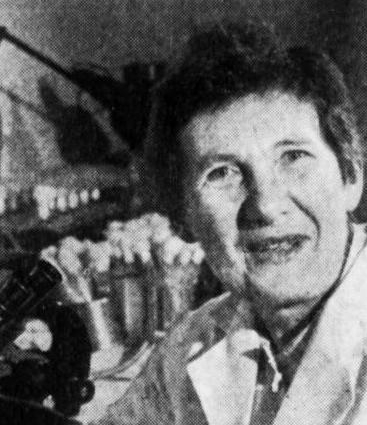



Provenance
1 - Fisher, Dr. Eileen E.
1 - Fisher, Dr. Eileen E.
|
Home Provenance Series List Search |
| Date Range | 1909 - 1998 | ||||||||||||||||||
| Details Eileen E. Fisher (born 1909) completed a B.Sc. in 1930 and an M.Agr.Sc. in 1931, both at the University of Melbourne. Her M.Agr.Sc. thesis submitted to the Department of Agriculture and Forestry was titled "Observations on fomes pomaceus (pers.) big. & guill. infecting plum trees : An investigation of ‘sooty moulds’ with particular reference to their taxonomy and their growth in culture". Her years in education were significant in the context of Eileen Fisher's overall career and evident interests. The broad subject of her thesis - funghi and its effect on agriculture - would be a key theme throughout her 45 year academic and professional career. In addition, she was studying at a time when mycology and plant pathology were strong disciplines in the University’s Botany Department, largely due to the work of Associate Professor Ethel McLennan (1891-1983), known as Dr Mac. The years around 1930 were considered a high point for women's involvement in Botany in general; and Fisher was conducting her research in an environment where Dr Mac and other women were active and prominent figures. Over the next two decades, Fisher continued studying and publishing on sooty moulds, completed her PhD at Newnham College, Cambridge University (1938), and commenced her professional career, working in the tertiary sector as Senior Demonstrator in Botany, the University of Melbourne, until 1946, and as Lecturer in Botany, the University of Queensland, from 1946 to 1949. In 1949, Dr. Fisher started as a Plant Pathologist with the Victorian Department of Agriculture, where she would work for the next 20 years. Her early work there can be related to her Masters thesis, being a focus on fungal diseases of fruit crops, working at the Plant Research Laboratory at Burnley with P. T. Jenkins (who also joined the Laboratory in 1949) under the Chief Biologist of the institute, Stan Fish. By the 1960s, the focus of Eileen Fisher’s work on funghi looks to have shifted from its effects on crops to problems it could cause for livestock and other animals. For example, in 1960, Dr. Fisher undertook a three month overseas trip, partly private and partly official, to New Zealand, England and America to study facial eczema in sheep; and in the 1960s her work included studies of toxic strains of funghi associated with sickness in dairy cattle, and their effects on mice, guinea pigs and rabbits. This shift in focus led to the last stage of Dr. Fisher’s professional career, working for the Veterinary Research Institute at the University of Melbourne, from 1970 to 1975. Besides her work as a mycologist, the second aspect of Eileen Fisher’s life evident in her records is an interest in women’s education, pay, and related issues. As with Dr Mac - herself a renowned mycologist and botanist, and considered a "tower of strength to women students" (Ducker, 2007) - Fisher looks to have been an active member of associations for Women Graduates and the Australian Federation of University Women. And while working at the Burnley Horticultural College, Margaret Dick recalls, Eileen Fisher actively sort to provide opportunities to help her female students advance. To this end, she was instrumental in the establishment of a new microbiology course at the RMIT (though it did not ultimately include the subjects she wanted). Dr. Eileen E. Fisher died in 1998. | |||||||||||||||||||
| Chronology | |||||||||||||||||||
| |||||||||||||||||||
| References | Sophie C. Ducker, "Ethel McLennan 1891-1983 botanist", in Heather Radi (ed.) 200 Australian Women: A Redress Anthology, Women’s Redress Press Inc., 1988; Online Edition (organised by Jill Ogilvie) 2007, http://pandora.nla.gov.au/pan/78644/20071105-1315/www.200australianwomen.com/names/147.html. Date Accessed: 22 September 2009. Jane Carey, "Blackwood, Dame Margaret (1909-1986)", Australian Dictionary of Biography, Online Edition, Australian National University, 2006, http://www.adb.online.anu.edu.au/biogs/A170107b.htm. Date Accessed: 5 August 2009. Bill Washington, Ian Pascoe, Peter Merriman and Frank Greenhalgh, "Obituary - P. T. Jenkins - 1927-2006", Australian Plant Pathology, 37, 2008, p. 201, Online version, CSIRO Publishing, 2008, http://www.publish.csiro.au/?act=view_file&file_id=AP07095_OB.pdf. Date Accessed: 15 July 2009. Unknown author, "Research Work: To Aid Sheep Industry", The Age, Wednesday, June 15, 1960, p. 12, Online version, http://news.google.com/newspapers?id=jZ8UAAAAIBAJ&sjid=TasDAAAAIBAJ&pg=3360%2C2442687. Date Accessed: 22 September 2009. "Miss Margaret Dick (1918-2008) - Food microbiologist", Interviewed by Dr Ann Moyal in 2000, Interviews with Australian Scientists, Online Edition, Australian Academy of Science, c.2008, http://www.science.org.au/scientists/md.htm. Date Accessed: 14 July 2009). | ||||||||||||||||||
|
Published by the The University of Melbourne eScholarship Research Centre on AustehcWeb, September 2009
ISBN 978-0-7340-4116-6 Listed by Michael Jones, with Arlie McCarthy HTML edition Updated 3 August 2020 http://www.austehc.unimelb.edu.au/guides/fisc/FISP001.htm The template for this finding aid is part of the Heritage Documentation Management System |
[ Top of Page | Home | Series | Provenance | Search ] |